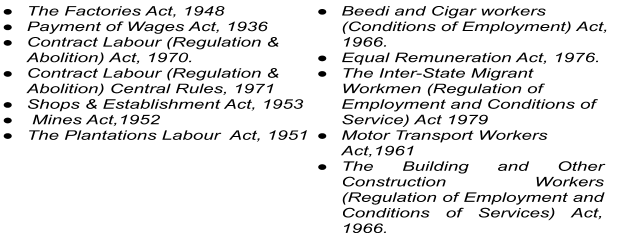This article is written by Vijay Giri Goswamy, pursuing a Diploma in Labour, Employment and Industrial Laws for HR Managers from LawSikho.
Table of Contents
Introduction
In India, the Constitution is the main source for all the laws, most of the labour laws are emanated as Central acts and few like Shops and Establishment Act etc., can be seen as State laws. We have experienced a quantum leap in workforce demand to catch up and sustain with the growth due to economic liberalisation. Ministry of MSME, GOI, estimated to employ about 73 million workers in over 31 million units through the country, the major industries in the Indian Economy are Iron & Steel, Textile, Jute, Sugar, Cement, Paper, Petrochemical, Automobile, Information & Technology (IT) and Banking & Insurance. Construction, trade, transport, storage, miscellaneous services and education has created jobs post-liberalisation / globalisation. Without statutes, employees would be vulnerable to a number of threats in their employment.
Shift work
In today’s day, general working hours concept i.e. office hours is 9 hours (with 45-60 min. of break) but in manufacturing units governed under various statutes, the work being on continuous process different teams of workers must be organised in staggered or successive shifts to cover the work throughout operating period. Rotating shifts here means employees are subject to variations in working time, which is divided into shifts of maximum 8 hours as stipulated in the statutes, there are 3 shifts (two in day and one in night) in general concept of shifts and a general shift which is equal to office hours. As working time is fixed or rotating, or staggered or successive shifts, no additional remuneration is due in this arrangement. Where work is being done beyond this provision by a particular employee attracts over-time where he is eligible for compensation either monetarily or as per any agreement.
Globalisation – the paradigm shift
The effects of Globalisation was tandem on working culture and invariably on timings too, as to cater to the global market working on global time clock became inevitable, leveraging the night work in India. However, some adverse impact of night work on an individual i.e. his/her family due to change in the body clock leading to stress which would eventually lead to medical conditions that disturb the entire family. The individuals who cope or get into the night work grove generally get socially disengaged.

This issue in the manufacturing sector is minimised to a major extent due to rotational shift duties. But, in the present scenario, IT companies (BPOs, Call centres where allied services to many industries are provided globally) require a set of dedicated staff handling night work which is fixed with their employment. Some of the night jobs are: Jobs in Tech, Sales, BPO sales, Phone banking, Fleet managing executives, managers, customer service operations, network administrators, import/ export documentation, paramedics etc., Remuneration in this industry is competitive with provisions provided as per norms (Statutes).
As per the Job portals in India, there are around 50 thousand plus jobs (approx).
These jobs are mostly around 25 to 30 job locations i.e. in the main cities in India.
The Regulation
In order to protect every employee’s interest and rights, under the Constitution of India, Articles 14-16, 19(1)(C), 23-24, 38 and 41-43A are directly concerned with the labour laws in India.
There are about 42-44 Central laws which are the basis for most of the labour laws and their regulations. We should also be aware that applicability of these major laws is based on the head count or number of employees engaged in any establishment. While few statutes like Minimum Wages is not based on the number of employees but based on Schedule. The regulating and enforcing authorities in respect to Central and State department are – Regional Labour Commissioner (Central) and Labour Commissioner (State) of respective states and below them hierarchy as labour department of respective central and states.
Some of the statutes in India are:

Some laws such as Factories Act, Industrial Disputes Act may not be applicable to IT and ITES companies in some states. Also some state governments in their power have exempted IT and ITES companies from the application of some laws such as the Industrial Standing Orders Act.
The ‘workforce’ are categorised in organised and unorganised sectors (all public sector establishments and non-agricultural private establishments are under Organised Sector, whereas all others form the Unorganised Sector). About seven percent (7%) of the total workforce is employed in Organised Sector and rest ninety three percent (93%) are in the Unorganised Sector. The total workforce in our country is 45 crore (450 million), of which 41.5 crore (415 million) are people working in the Unorganised sector.
Legislations pertaining to overtime and night shifts
In India legislations like the: Plantation Labour Act, 1951, Factories Act, 1948 and State wise Shops & Establishment Act, etc., contain provisions restricting work during night for women.
Night shifts generally refer to working hours between 7.00 pm to 6.00 am.
|
Statutes |
Overtime |
Night Shifts |
|
Contact Labour (R&A) Act, 1970 |
||
|
Contract Labour (R&A) Rules, 1971 |
U/s 78 of the Act the contractor should maintain a register for overtime and record hours worked and wage paid for overtime. Update the overtime of all workers Half yearly in half yearly returns to the authorities. |
|
|
Register for Overtime in– Form XXIII [Rule 78(1)(a)(iii)]. |
||
|
Factory Act, 1948 |
Extra wages- if works for more than 8 hours in any day or 48 hours in a week. Twice his ordinary Rate (on daily/ weekly basis). |
Section 66(1)(b) of the Factories Act, 1948, states no woman shall be required or allowed to work in any factory except between the hours of 6 am and 7 pm. |
|
Remarks on FA,1948 |
After much debate the ban has been lifted in the majority of industries. For instance, the Factories Act, 1948,” now liberalised women to work at their desired timing”. It was argued for safety of women should be implemented such as provision of transportation till the doorstep of their residence rather than their ban at work during those hours. Today in four districts, there are about 40 thousand women employees doing three shifts, including night shift. |
|
|
Mines Act, 1952 |
As per section 33, working hours above ground – 9 hours, Below ground – 8 hours, or 48 hours in a week, if any overtime performed, should be compensated with twice his ordinary Rate (on daily / weekly basis). |
u/s 28 & 29- a weekly days rest i.e. 24 hours from end of his night shift. Section 46(1)(b) of the Act, prohibits employment of women in any mine above ground except between the hours of 6 am and 7 pm. |
|
Remark on MA,1952 |
u/s 48 sub-section(4)- register of persons employed to be maintained, showing their period of work in below ground mine. u/s 39 clause (a) & (b)-Limitation of daily work hours including overtime is 10 hours (in a day). |
|
|
Minimum Wages Act, 1948 |
As section 14, when a minimum wage of an employee is fixed for a particular period of time, and that employee works beyond that period, then the employee has to be paid overtime wages for the extra time. |
|
|
Remark on MW,1948 |
||
|
Beedi & Cigar workers (Conditions of Employment)Act, 1966 |
U/s 17 & 18 no one to work for more than ten hours a day / fifty hours a week, including overtime. |
Section 25 of the Beedi and Cigar Workers (Conditions of Employment) Act, 1966, stipulates that no woman shall be required or allowed to work in any industrial premises except between 6 am to 7 pm. |
|
Remarks on B&CW, 1966 |
||
|
Plantation Labour Act, 1951 |
Extra wages- if works for more than 9 hours in any day or 48 hours in a week. Twice his ordinary Rate (on daily/ weekly basis). |
|
|
Remarks PL, 1951 |
||
|
Building and Other Construction Workers Act, |
||
|
Shops & Establishment Act, 1953 |
Over time is applicable to all managerial and non-managerial positions, in every Indian Shops & establishment. |
According to Shops and Establishments, no women shall be required or allowed to work in any establishment after 9.30 pm. In the IT industry provision of women employees working after 8 pm. Is allowed provided transportation till doorstep and other security measures for women employees are adhered. |
Provisions of overtime
As per section 51 and 59 of the Factories Act,1948 working hours stipulation is mentioned, employees must be provided at least one break of half an hour between the working hours in the entire period of work. Overtime is paid either on a per hour or as per piece rate in factories. It also specifies punishment in case an employer violates these provisions.
Provisions of night shift
Industry-wise the provisions are made, such as manufacturing industry – employee/workforce working in shift are provided with:
- Transportation
- Reduced workload
In IT industry there is provision for women employees working after 8.00 pm i.e. special arrangements like transportation from office till doorstep, schedule job shift jointly in group gender wise, vehicle transporting women employees to be given special pass, Vehicle transporting women staff in night should be equipped with:
- GPS device, SMS alert to be initiated, Collection of identification details of the driver.
Conclusion
However, currently with reforms to labour laws introduced as Code on Wages 2019, Industrial Relations Code 2019 and Code on Social Security, there aren’t considerable changes related to overtime and night shift. There should have been more emphasis on shifts where work involves night work that – provide better financial compensation, safety and health and more provisions apart from the above.
Students of Lawsikho courses regularly produce writing assignments and work on practical exercises as a part of their coursework and develop themselves in real-life practical skill.
LawSikho has created a telegram group for exchanging legal knowledge, referrals and various opportunities. You can click on this link and join:
 Serato DJ Crack 2025Serato DJ PRO Crack
Serato DJ Crack 2025Serato DJ PRO Crack











 Allow notifications
Allow notifications



